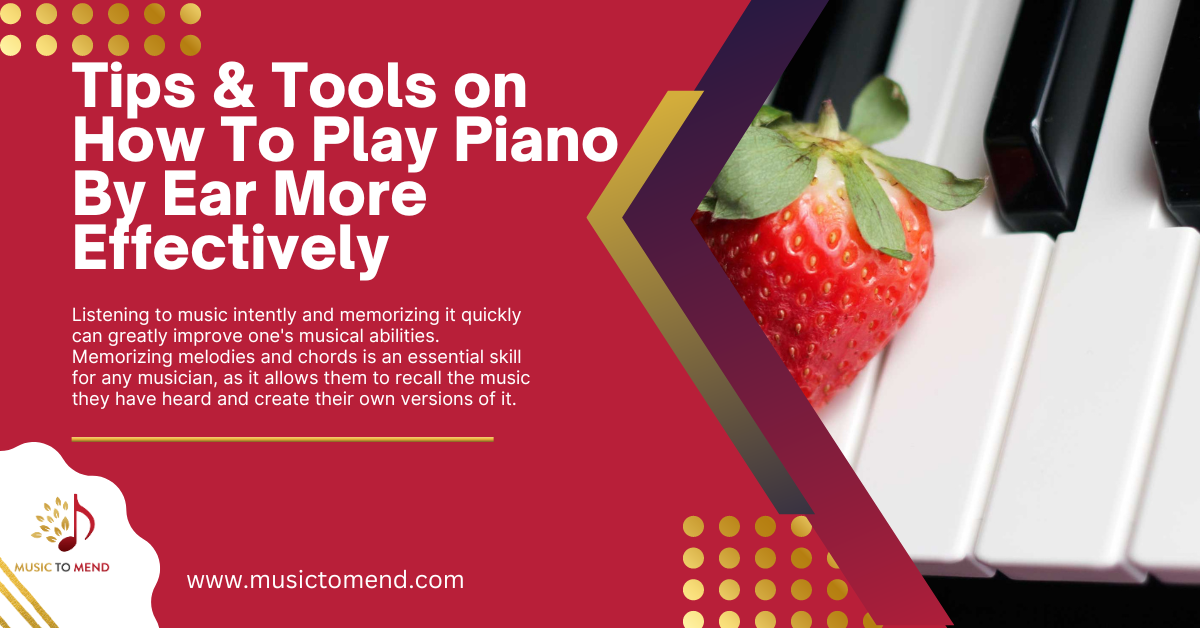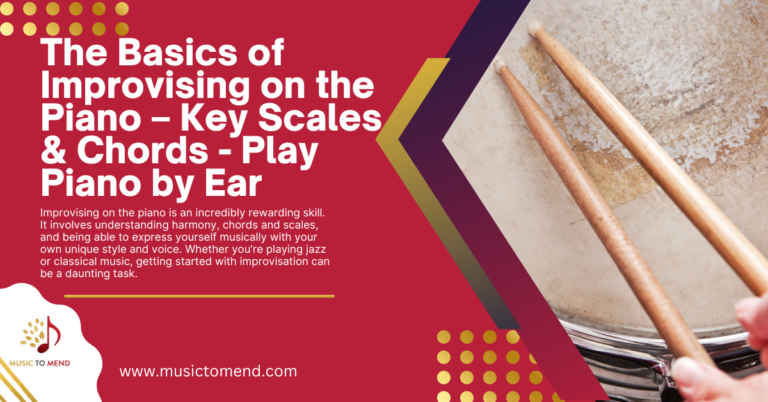5 Amazing Tips & Tools on How To Play Piano By Ear More Effectively

In today’s article, I’ll be discussing ways to play piano by ear more effectively. Listening to music intently and memorizing it quickly can greatly improve one’s musical abilities. Memorizing melodies and chords is an essential skill for any musician, as it allows them to recall the music they have heard and create their own versions of it. The key is to make it fun to do. Take a familiar song, and play it on the piano with your eyes closed. Then, you open your eyes and sing your song lyrics while playing only the piano. If you don’t want to sing the song, you can hum it instead. This allows you to not only memorize how the music sounds like but also see how it looks when memorized by ear first, then sight. This is a great way to train both of these senses at once!
With regular dedication and practice, honing the ability to play piano by ear is a rewarding experience. You don’t need to worry about sheet music or any written material; it’s all about training your ears to recognize notes, chords & melodies! Playing piano by ear has many benefits, including improved memory, creativity, and confidence. Ear training can also help you learn faster and become more intuitive in your playing. With dedicated practice, anyone can learn to play piano by ear. The key is to make it fun to do. Take a familiar song, and play it on the piano with your eyes closed. Then, you open your eyes and sing the lyrics of your song while playing only the piano. This allows you to not only memorize how the music sounds like but also see how it looks when memorized by ear first, then sight. This is a great way to train both of these senses at once!
So, let’s dive right into the 5 Tips to play piano by ear more effectively!
Tip #1 – Listen and Memorize Music Intently
Listening to music intently and memorizing it quickly can be a great way to improve one’s musical abilities. Memorizing melodies and chords is an essential skill for any musician, as it allows them to recall the music they have heard and create their own versions of it. The key is to make it fun to do. Take a familiar song, and play it on the piano with your eyes closed. Then, you open your eyes and sing the lyrics of your song while playing only the piano. This allows you to not only memorize how the music sounds like but also see how it looks when memorized by ear first then sight. This is a great way to train both of these senses at once!
Tip #2 – Learn the Musical Scales and Learn How to Improvise
Knowing the musical scales and learning improvisation techniques for piano is an essential skill for any aspiring pianist. By mastering these skills, a pianist can create beautiful music from scratch, or in response to another musician’s playing.
Learning the musical scales is the foundation for understanding how to improvise on the piano. Once you have a basic understanding of the notes and chords, you can start to explore different improvisation techniques such as using arpeggios, playing in different keys, and experimenting with rhythm and dynamics. With practice, you will be able to create unique music that expresses your individual style!
Tip #3 – Train Your Ear with Different Exercises
Ear training exercises are a great way to develop your relative pitch on the piano. It is important to train your ear if you want to become a better musician and understand music theory. With regular practice, you can improve your ability to recognize intervals, chords, and scales by ear.
This tip focuses on three simple yet effective ear training exercises that you can use to train your ear and develop relative pitch on the piano. These exercises will help you identify notes, chords, and progressions accurately without having to look at the keys or sheet music. With just a few minutes of practice every day, you will be able to hear musical patterns more clearly and play with greater accuracy.
Tip #4 – Get Familiar with Different Chord Progressions & How They Work
For those who want to master the piano, understanding chord progressions is an essential skill. Knowing how to recognize chords on the piano can help you create beautiful music that will captivate your audience. It can also help you develop a better sense of musicality and make it easier for you to improvise and create new pieces. Being familiar with different chord progressions will allow you to explore different musical possibilities and create unique sounds that will take your music to the next level. A standard chord progression is a basic outline of how to move through a song. As you learn more about chord progressions, try adding some of your own and expanding on these basics.
Tip #5 – How to Use Your Imagination to Create Unique Melodies & Arrangements on Piano
The piano is a great instrument for creative composition. With your imagination, you can create unique melodies and arrangements that will sound beautiful and captivating. Whether you are a beginner or an experienced musician, there are several creative composition techniques that you can use to craft the perfect piece of music.
From using musical ideas generators to exploring musical motifs, plenty of tools are available to help you develop unique melodies and arrangements on piano. With these tools, you can create something truly special that will stand out from the rest of the crowd. So why not take advantage of them and start creating your own compositions today?
I hope you enjoyed this blog post.
Until next time, stay well and happy piano-playing,
Bea







